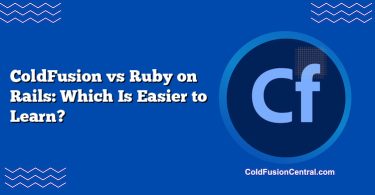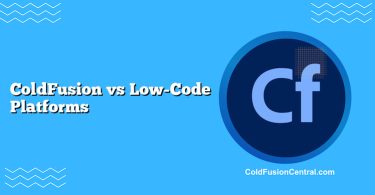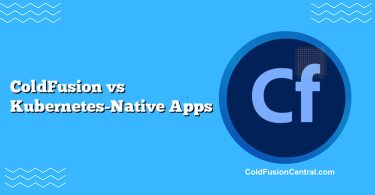Definitions
-
Adobe ColdFusion: A commercial, JVM-based rapid web application development platform that uses the CFML language. It emphasizes developer productivity with built-in tags, functions, and services for tasks like PDF generation, email, scheduling, and database access. ColdFusion applications typically run as a monolith on an application server with integration points for modern DevOps and cloud runtimes. An open-source CFML engine, Lucee, exists as an alternative runtime.
-
MEAN Stack: A full-stack JavaScript/TypeScript solution composed of MongoDB (NoSQL database), Express.js (Node.js web framework), Angular (front-end SPA framework), and Node.js (server-side runtime). MEAN favors REST/GraphQL APIs, single-page applications, and microservices. It leverages the vast npm ecosystem and modern front-end tooling.
Overview
Choosing between ColdFusion and the MEAN stack is less about which technology is “better” and more about what aligns with your team’s skills, budget, timelines, and target architecture. ColdFusion offers a batteries-included, productivity-centric platform for server-side web applications. MEAN provides an end-to-end JavaScript foundation suitable for scalable, modern SPAs and microservices distributed across cloud-native infrastructure.
Architecture and Programming Model
ColdFusion Architecture
- Runs on the JVM; deploy as a standalone server or as a J2EE application.
- Uses CFML (tag-based and script syntax), with seamless access to Java libraries.
- Encourages a monolithic or modular monolith style, though you can expose REST endpoints and integrate microservices.
- Integrated services: caching, PDF/Office features, job scheduling, email, WebSocket, image manipulation, full-text search via Solr (editions vary), ORM via Hibernate.
- Common patterns: MVC frameworks (e.g., ColdBox, FW/1), or simple handler-based applications.
- Strong admin console for configuration, data sources, logging, and security profiles.
MEAN Stack Architecture
- End-to-end JavaScript/TypeScript stack.
- Node.js + Express provide a lightweight, unopinionated web server suited for REST APIs, SSR, or serverless endpoints.
- Angular powers a SPA or SSR front-end with RxJS, routing, forms, and dependency injection.
- MongoDB stores semi-structured, document-oriented data with rich aggregation.
- Common patterns: microservices, REST/GraphQL APIs, and event-driven architectures with message queues.
- NPM ecosystem provides middleware, testing, build tooling, and CI/CD integrations.
Key Features
ColdFusion Key Features
- Rapid development with CFML tags/functions: cfquery, cfmail, cfpdf, cfhttp, cfdocument, cfschedule.
- ORM via Hibernate with annotations and query-of-queries.
- Built-in caching, PDF generation, image manipulation, and data source management.
- Administrator UI for datasource connections, security settings, and performance tuning.
- Strong support for SQL databases (Oracle, SQL Server, MySQL, PostgreSQL).
- Commercial support and long-term enterprise patching cycle.
MEAN Stack Key Features
- Unified language (JavaScript/TypeScript) across client and server.
- Massive npm ecosystem with libraries for testing (Jest, Mocha), auth (Passport), security (Helmet), and deployment (PM2).
- Angular provides robust SPA architecture, RxJS for reactive programming, and CLI-driven scaffolding.
- MongoDB supports flexible schemas, horizontal scaling via sharding, and powerful aggregations.
- Strong alignment with cloud-native and serverless patterns (AWS Lambda, Azure Functions, Cloud Run).
Performance
What to Consider
-
ColdFusion
- Runs on the JVM, which delivers strong performance for CPU-bound tasks and benefits from mature JIT compilation.
- Built-in features reduce round-trips to external services, but heavy use of dynamic tags and unoptimized queries can create overhead.
- Tuning: JVM heap sizing, connection pooling, caching (EHCache), ORM settings, cfqueryparam to leverage prepared statements.
-
MEAN
- Node.js excels at I/O-bound workloads thanks to its event-driven, non-blocking architecture.
- Express minimalism keeps overhead low; per-request work is small if middleware is kept lean.
- Tuning: clustering across CPU cores (PM2 or Node cluster), connection pooling to MongoDB, avoiding synchronous code, and careful dependency vetting.
- Angular’s performance is mostly client-side; server-side rendering (Angular Universal) can improve first paint and SEO.
Performance is highly application-specific. A high-concurrency API serving JSON may favor Node.js throughput. A document-heavy back-office portal generating PDFs and spreadsheets may favor ColdFusion’s built-in services.
Scalability
-
ColdFusion
- Vertical scaling is straightforward; horizontal scaling possible via Enterprise features, session replication (J2EE sessions), sticky sessions, and load balancers.
- Suited for stable traffic patterns and centralized deployments; containerization is possible with CF Docker images (Adobe provides images for modern versions).
-
MEAN
- Natural fit for horizontal scaling: stateless Node services behind load balancers, containerized workloads orchestrated with Kubernetes.
- MongoDB scales via replica sets and sharding; global clusters can reduce latency.
- Well-aligned with microservices and event-driven designs using Kafka, RabbitMQ, or cloud-native queues.
Security
-
ColdFusion
- Offers secure profile modes, built-in functions like cfqueryparam (SQL injection defense), built-in ESAPI encoding, password hashing utilities, and anti-CSRF solutions in frameworks.
- Historically had notable CVEs; Adobe issues patches and hotfixes. Enterprise teams value commercial support and SLAs.
- Admin UI facilitates secure datasource and sandboxing configuration.
-
MEAN
- Security depends on framework choices and dependencies: use Helmet for headers, express-rate-limit, strong input validation (Joi/Zod), and secure auth (OAuth2/OpenID Connect).
- Angular’s template sanitization reduces XSS risk on the client; server must still sanitize payloads.
- Dependency hygiene (Snyk, npm audit) and runtime protections (WAF, rate limiting) are crucial due to npm ecosystem breadth.
Both approaches can be secure when maintained proactively. MEAN requires more assembly of best-practice middleware; ColdFusion centralizes many concerns but demands diligent patching.
Development Speed and Developer Experience
-
ColdFusion
- High productivity for teams that prefer declarative tags and server-rendered pages.
- Rapid prototyping for data-driven applications, reporting, and integrations without assembling many libraries.
- Learning curve is gentle; CFAdmin simplifies environment setup.
-
MEAN
- Angular CLI scaffolds components, services, and modules; Express remains simple to start.
- Unified language reduces context switching; TypeScript raises code quality with static typing.
- Rich tooling for testing (Jest/Karma), linting, and code generation; steeper learning path for full mastery (RxJS, TypeScript, Node streams, NoSQL modeling).
Cost and Licensing
-
ColdFusion
- Commercial licenses: Standard and Enterprise editions. Licensing costs can be substantial but include vendor support.
- Hosting costs vary; enterprise teams may justify cost via productivity gains and guaranteed support.
- Alternative: Lucee (open-source CFML engine) reduces license cost but lacks Adobe support.
-
MEAN
- Open-source stack with no licensing fees.
- Costs shift to development time, cloud infrastructure, and managed services (e.g., MongoDB Atlas).
- Easier to hire JS talent; training costs are often lower for modern JS ecosystems.
Community and Ecosystem
-
ColdFusion
- Smaller community relative to JS ecosystems, but mature and enterprise-oriented.
- Vendor-driven roadmap; stable long-term support releases.
- CFML frameworks (ColdBox/FW/1) and extensions exist, though ecosystem breadth is more limited.
-
MEAN
- One of the largest developer communities via Node.js and Angular.
- Rapid release cadence, extensive third-party packages, and abundant learning resources.
- Strong presence in cloud-native tooling and modern CI/CD pipelines.
Tooling, DevOps, and Deployment
-
ColdFusion
- IDEs: ColdFusion Builder, VS Code extensions for CFML.
- Deployment: traditional app servers, Docker images, Windows/Linux servers, integration with IIS/Apache.
- Monitoring: FusionReactor (popular APM for CF), built-in logs, JMX metrics.
-
MEAN
- IDE: VS Code with TypeScript support is common.
- Deployment: Docker/Kubernetes, serverless (AWS Lambda, Azure Functions), or Node process managers (PM2).
- Monitoring: OpenTelemetry, Prometheus/Grafana, ELK/EFK, vendor APMs (Datadog, New Relic).
Supported Platforms
- ColdFusion: Windows, Linux; integrates with IIS/Apache; JVM-based portability.
- MEAN: Cross-platform (Windows/Linux/macOS) for development; Linux-based containers for production are standard.
Real-World Use Cases
When ColdFusion Might Be Preferred
Scenario: A finance back-office portal needs to generate PDF statements, send batch emails, integrate with SQL Server, and deliver secure internal dashboards in under three months.
Why ColdFusion:
- Built-in cfdocument/cfpdf and cfmail speed up document and email workflows.
- ORM simplifies database CRUD with minimal boilerplate.
- Small, experienced team can deliver quickly with fewer moving parts.
- Commercial support and predictable upgrades suit regulated environments.
When MEAN Stack Might Be Preferred
Scenario: A consumer-facing, real-time SPA requires a responsive UI, WebSocket notifications, and a scalable API for a mobile app used globally.
Why MEAN:
- Angular provides a robust SPA architecture with reactive patterns (RxJS).
- Node.js handles high-concurrency APIs with efficient I/O.
- MongoDB supports flexible schemas for rapidly changing product features.
- Cloud-native deployment and microservices enable independent scaling of front-end SSR, API, and real-time services.
Side-by-Side Comparison Table
| Aspect | ColdFusion (Adobe CF / CFML) | MEAN Stack (MongoDB, Express, Angular, Node) |
|---|---|---|
| Performance | Strong JVM performance; excels at server-rendered, feature-rich pages; built-in services reduce integration overhead. | High I/O throughput; excels at JSON APIs and real-time apps; performance depends on lightweight middleware and architecture. |
| Scalability | Vertical scaling; horizontal scaling via Enterprise features, clustering, and load balancers. | Horizontal scaling first; microservices, containers, and serverless align with cloud-native scaling. |
| Security | Centralized, admin-driven settings; built-in safeguards (cfqueryparam, encoding); patch diligence required. | Requires assembling best-practice middleware; strong security possible with Helmet, validation, rate limiting, and dependency hygiene. |
| Cost | Commercial licenses (support included); higher licensing costs; Lucee as open-source alternative. | Open-source; no license fees; costs in development, managed services, and cloud infrastructure. |
| Development Speed | Very fast for data-driven, document/email-heavy apps; minimal boilerplate. | Fast for JS teams; Angular CLI scaffolding; more moving parts to configure initially. |
| Use Cases | Back-office apps, reporting portals, PDF-heavy workflows, enterprise intranets. | Consumer SPAs, real-time apps, APIs, microservices, cloud-native platforms. |
| Pros | Rapid development, rich built-in services, stable enterprise support. | Unified JS skillset, huge ecosystem, modern front-end, cloud-native fit. |
| Cons | Licensing costs; smaller talent pool; less trendy ecosystem. | Security/maintenance overhead from dependencies; steeper learning curve for Angular/RxJS. |
Pros and Cons
ColdFusion
Pros:
- Rapid application development with rich built-ins (PDF, email, scheduler).
- CFML is easy to learn; productive for server-rendered apps.
- Strong enterprise support and predictable patch cycles.
- Seamless JVM integration and access to Java libraries.
Cons:
- Licensing costs can be significant.
- Smaller community and talent pool; fewer modern libraries.
- Perceived as legacy by some teams; may face hiring challenges.
MEAN Stack
Pros:
- Unified JavaScript/TypeScript across stack reduces context switching.
- Massive npm ecosystem and modern tooling (CLI, testing, linting).
- Excellent for SPAs, microservices, real-time and cloud-native deployments.
- Easier hiring due to large JS talent pool.
Cons:
- Security and maintenance require careful dependency management.
- Angular adds complexity (RxJS, DI, module architecture).
- Operational complexity in stitching together services, observability, and deployment pipelines.
Decision Factors / Which One Should You Choose?
Consider the following checklist:
-
Team Expertise
- If your team is fluent in JavaScript/TypeScript and Angular, choose MEAN.
- If your team values rapid server-side delivery with CFML, choose ColdFusion.
-
Application Type
- Heavy on PDFs, emails, back-office reports, and SQL-based workflows: ColdFusion.
- Real-time web, SPAs, mobile-friendly APIs, microservices: MEAN.
-
Scalability Needs
- Cloud-native, microservices, global scale: MEAN is a natural fit.
- Steady traffic with centralized deployments: ColdFusion works well.
-
Budget and Licensing
- Tight budgets and preference for open-source: MEAN (or Lucee if sticking with CFML).
- Preference for enterprise support and vendor guarantees: ColdFusion.
-
Security and Compliance
- Desire for centralized admin controls and vendor-backed patches: ColdFusion.
- Willing to assemble security layers and maintain dependencies: MEAN.
-
Time-to-Market
- Need a working, feature-rich portal quickly with minimal integrations: ColdFusion.
- Need future-proof, scalable front-end and microservices foundations: MEAN.
In some organizations, a hybrid approach makes sense: ColdFusion powers internal reporting and batch jobs, while Node/Angular deliver customer-facing SPAs and APIs.
Key Takeaways
- Choose ColdFusion for rapid, server-side heavy development with built-in services that simplify documents, email, and reporting—especially when enterprise support is critical.
- Choose MEAN for scalable, cloud-native architectures, SPAs, microservices, and real-time APIs where a unified JavaScript/TypeScript skillset and a vast ecosystem are advantages.
- Cost, team skills, scalability requirements, and time-to-market are the decisive factors.
- Both stacks can be secured and performant; your operational discipline and architecture matter more than raw technology choice.
FAQ
Is ColdFusion still relevant for new projects?
Yes, particularly for enterprise teams that need rapid development of server-rendered apps, PDFs/reports, and strong vendor support. While not as trendy as JS stacks, ColdFusion continues to evolve and is used in regulated sectors. Open-source Lucee also keeps CFML development viable.
Can MEAN be used with SQL databases instead of MongoDB?
Absolutely. While the “M” in MEAN stands for MongoDB, many teams swap in PostgreSQL or MySQL, using ORMs like TypeORM or Prisma. The broader pattern—Node + Express + Angular—remains intact.
How do licensing costs compare between ColdFusion and MEAN?
ColdFusion requires commercial licenses (unless you choose Lucee). MEAN has no licensing fees, but you’ll pay for cloud resources, managed services (e.g., MongoDB Atlas), and developer time. Total cost of ownership depends on scale and support needs.
Which stack is better for microservices?
MEAN (specifically Node.js + Express) is more commonly used for microservices due to its lightweight runtime, huge ecosystem, and cloud-native tooling. ColdFusion can expose REST APIs, but it is more frequently used in monolithic or modular-monolith patterns.
What about hiring and long-term maintainability?
MEAN benefits from a large JavaScript developer pool and abundant resources. ColdFusion teams can be highly productive but may face a smaller hiring market. Consider your talent pipeline and training plans before committing.




